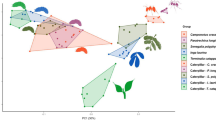Abstract
In 1975 and 1976 the leaf-rolling Microlepidoptera at birchtrees (Betula alba andB. pubescens) were investigated in the moor-land of Groebenzell western of Munich, Bavaria. Among the 14 species the GelechiidAnacampsis populella was predominant. The egg, larva and pupa, largely unknown hitherto, are described. In particular the chactotaxy of the larval stages are considered. The average number of eggs laid was 46.5, those of eggs within an egg cluster 6.5. The number of eggs remaining in the abdomen after death amounted to 9.5 per female. The larvae fed mainly on birch-trees and at a smaller scale on aspen. Willows and poplars were rejected. The first instar is living free at the underside of the leaf. Following the moulting the second instar rolls the leaf by help of spinning fibres.A. populella showed only one generation per year. The eggs overwintered. 20 species of parasitic Hymenoptera were reared: 10 larval, 4 pupal and 6 secondary parasites. The maximal quote of parasitation amounted to 59%.
Zusammenfassung
Im Gröbenzeller Moor, westlich von München wurden 1975 und 1976 die blattrollenden Mikrolepidopteren untersucht. Von den 14 festgestellten Arten war die GelechiideAnacampsis populella vorherrschend. Ei, Larve und Puppe, bisher weitgehend unbekannt, und besonders die Chaetotaxie der Larvenstadien, werden beschrieben. Die Zahl abgelegter Eier betrug im Mittel 46,5. Die Eier werden am Grunde von Knospen abgelegt. Die mittlere Zahl Eier pro Gelege betrug 6,5. Fast 87% der Weibchen hatten nach dem Tode noch legereife Eier im Abdomen, im Mittel 9,5 Stück. Fütterungsversuche ergaben, daß die Larven nur Birke (Betula sp.) und Aspe (Populus tremula) fraßen, Weiden- (Salix-)Arten und andere Pappeln (Populus) dagegen verschmähten. Die Erstlarven fressen frei an der Blattunterseite. Nach der ersten Häutung rollt jede Larve einzeln das Blatt, manchmal auch mehrere Blätter, mit Hilfe von Spinnfäden zu einer Rolle zusammen, in deren Innern sie frißt.A. populella hatte 1 Generation mit Überwinterung der Eier. Es wurden 20 parasitische Hymenopteren-Arten gezogen: 10 aus Larven, 4 aus Puppen sowie 6 Sekundärparasiten. Die mittlere Parasitierungsquote betrug maximal 59,0%.
Similar content being viewed by others
Literaturverzeichnis
Acatay, A., 1959: Pappelschädlinge in der Türkei. Anz. f. Schädlingsk. Pfl. u. Umweltschutz32, 113.
Bremer, H., 1929: Grundsätzliches über den Massenwechsel von Insekten. ZaE14, 254–272.
Burmann, K., 1956: Kleinfalterraupen an Pappeln in Nordtirol. Anz. f. Schädlingsk. Pfl. u. Umweltschutz29, 145–146.
Fischer, J. E. 1838. Abbildungen zur Berichtigung und Ergänzung der Schmetterlingskunde, besonders der Microlepidoptereologie. J. C. Hinrich's Söhne, Leipzig. 217S.
Gerasimov, A., 1935. Zur Frage der Homodynamie der Borsten von Schmetterlingsraupen. Zool. Anz.122, 177–194.
Schmitt, C., 1920. Die Zucht vonTachypilia populella aus Espenblatt Wickeln. Entom. Zeitschr., Frankfurt a. M.34 (13), 50–59.
Schütze, K., T., 1931: Die Biologie der Kleinschmetterlinge. Frankfurt a. M. Verlag des Internation. Entomologischen Vereins E. v., 235 S.
Schwerdtfeder, F., 1970: Die Waldkrankheiten. 3. Aufl. Hamburg und Berlin: Verlag Paul Parey 509 S.
Soenen, A., 1947: Les Tordeuses de nos arbres Fruitiers. Centra de Recherches de Gorsem.4, 1–18.
Spuler, A., 1913: Die sogenannten Kleinschmetterlinge Europas. Stuttgart.
Author information
Authors and Affiliations
Additional information
Mit 6 Abbildungen
Rights and permissions
About this article
Cite this article
Hassanein, F.A. Zur Morphologie, Biologie und Ökologie von Anacampsis populella (Clerck) (Lep., Gelechiidae). Anz. Schadlingskde., Pflanzenschutz, Umweltschutz 51, 20–23 (1978). https://doi.org/10.1007/BF01903247
Issue Date:
DOI: https://doi.org/10.1007/BF01903247




